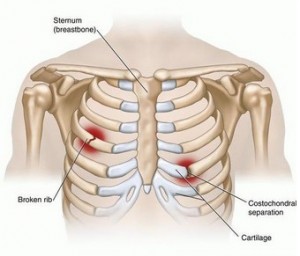Rib Fracture
Last Updated on August 12, 2024 by The SportsMD Editors
A rib fracture or broken rib is one of the more common injuries to the chest with rib fractures as the most common thoracic injury from blunt force trauma (i.e. automobile accidents, falls, or contact sports). Uncomplicated single rib fractures can be managed easily. However, multiple rib fractures may result in a pneumothorax, a life-threatening emergency.
There are 12 pairs of ribs that circle the chest for the primary purpose of protecting the heart and lungs. All of the ribs have a posterior attachment to the spine, but only 10 of the ribs have an anterior attachment to the sternum via costal cartilage. The flexible costal cartilage allows for the rib cage to expand during inspiration.
The last two ribs are known as “floating” ribs because they do not have an anterior attachment. Because these two ribs remain unattached, a fracture to these ribs may result in associated damage to the kidneys, liver, or spleen.
Located between each rib are small external and internal intercostal muscles. These muscles are responsible for elevating and then returning the ribs to their natural position during breathing. These muscles can also be injured during a chest injury.
What types of rib injuries are there?
There are a number of possible injuries involving the ribs including stress fractures, nondisplaced simple fractures, displaced multiple fractures, and costochondral separation (separation between the costochondral cartilage and the rib).
Rib stress fractures can be seen in athletes with a history of violent muscle contractions as can be seen in the sport of weightlifting. Stress fractures can also be seen in golfers, rowers, and baseball pitchers.
A stress fracture is a small partial fracture in the bone. These can be painful, but are not dangerous and have a good prognosis with rest and time for healing.
Simple nondisplaced rib fractures are most commonly seen in ribs five through nine from blunt force to the front or back of the body. A simple nondisplaced fracture means that there is a break through the bone, but the bone ends remain in their original position. These types of fractures also have a good prognosis with rest.

However, displaced multiple fractures can be life-threatening. Displaced multiple fractures can leave sharp bony fragments that may puncture the pleural sac surrounding the lungs. This can lead to a pneumothorax or a collapsed lung. These types of injuries are the most serious with the athlete needing immediate emergency medical treatment.
The last common injury in and around the ribs is a separation of the anterior rib from its costochondral attachment. The costochondral cartilage attaches the anterior rib to the sternum. This type of injury can occur during a collision or as the result of a severe twisting motion of the thorax.
This type of injury can either result in a tear between the sternum and the costochondral cartilage or a tear between the costochondral cartilage and the rib. The tear may be accompanied by a “popping” sound with localized sharp pain for a few days. Unfortunately, this type of injury may result in chronic pain.
Rib fracture complications
The most severe and critical complication of displaced rib fractures is a pneumothorax. A displaced rib fracture can puncture the lungs and the pleural sac surrounding the lungs effectively deflating the lung on the side of the pleural puncture. As the lung deflates, the athlete will have increasing pain and difficulty breathing.
A pneumothorax should be suspected if an athlete exhibits any of the following signs and or symptoms:
• Anxiety/restlessness
• Painful breathing
• Increased heart rate
• Cyanosis
• Distended neck veins
• Severe chest pain
• Decreased or absent breath sounds of affected lung
• Decreased blood pressure
• Asymmetric chest expansion
If a pneumothorax is suspected, emergency medical services should be immediately called. The athlete should be kept calm and quiet with a focus on slow and controlled breathing.
Symptoms for Rib fracture
If the mechanism of injury for the athlete involves a direct blow to the ribs or an indirect force resulting in the compression of the broken rib cage, the presence of the following signs and symptoms may indicate a rib fracture:
• Localized swelling
• Discoloration
• Increased pain on deep inspiration
• Pain on palpation of injured area
• Visible deformity
• Shallow breathing
• Increased pain on trunk rotation and lateral flexion away from fracture site
• Cyanosis
• Rapid, weak pulse and low blood pressure with multiple fractures
• Individual may lean towards injured side
Rib fracture Pain
A rib fracture or broken rib can be very painful because your ribs may move when you breathe, cough, and shift your upper body. Strong pain in your chest area will happen when you breathe or when you do any simple movements. The area of the fracture will be very tender and you may feel the need to lean to the injured side or hold it with your arm and hand.
How is a rib fracture diagnosed?
Because the symptoms of a bruised rib, fractured rib, and broken rib are very similar, a rib fracture x-ray should be ordered to rule out a fracture. The diagnosis should also include a thorough medical history, physical examination, and auscultation (exam with a stethoscope to listen for breath sounds).
Who gets rib fractures?
Single and multiple rib fractures or broken ribs have the highest incidence in collision sports including wrestling and football and contact sports such as basketball and soccer. Stress fractures can be seen in athletes with repetitive upper extremity motions as seen in the sports of throwing athletes, golfers, and rowers.
Causes of rib fractures
Rib fractures can be caused by both direct and indirect forces. Direct forces would include being hit, kicked, or punched with the resulting fracture at the site of contact.
An indirect force can cause rib fractures through general compression of the rib cage as when a football player is compressed by another player during a tackle. The weight of the opposing player can compress the injured player against a hard surface. If the external force is stronger than the tensile force of the ribs, the bones can be fractured.
Prevention of rib fracture
Rib injuries often occur through accidental injury in sports or recreation. However, when it applies, protective gear should be properly fitted and worn.
Treatment of Rib fracture
 Unlike other fractures in which the bone is immobilized to reduce pain and enhance the healing process, the ribs cannot be effectively immobilized because they need to expand in order for the individual to breathe. The treatment for rib fractures typically focuses on managing pain and ensuring proper healing. In the case of simple rib fractures, pain management with medications is often sufficient. Patients are encouraged to use an incentive spirometer (pictured here), a medical device that helps improve lung function and prevent complications such as pneumonia. If pain persists despite medication, alternative pain relief methods like nerve blockage may be considered.
Unlike other fractures in which the bone is immobilized to reduce pain and enhance the healing process, the ribs cannot be effectively immobilized because they need to expand in order for the individual to breathe. The treatment for rib fractures typically focuses on managing pain and ensuring proper healing. In the case of simple rib fractures, pain management with medications is often sufficient. Patients are encouraged to use an incentive spirometer (pictured here), a medical device that helps improve lung function and prevent complications such as pneumonia. If pain persists despite medication, alternative pain relief methods like nerve blockage may be considered.
For patients with multiple rib fractures, in addition to pain medication, oxygen support may be necessary to assist with breathing.
A small pneumothorax may be able to heal on its own. In this case, you may only require oxygen and rest to make a full recovery. A doctor may also release additional air around the lung by sucking it out through a needle or insertion of a chest tube, which allows the lung to fully expand.
In more severe cases, such as a flail chest where multiple ribs are broken and breathing is severely affected, ventilatory support may be required to maintain proper oxygen levels. Surgical intervention, including the use of metal plates to repair the fractured ribs, may also be considered to help stabilize the chest and improve the patient’s overall condition.
Taping a rib fracture is generally not recommended as a standard treatment approach. Taping or binding the chest can restrict breathing and may lead to complications, such as pneumonia or reduced lung function.
The specific treatment plan depends on the severity of the rib fractures. Always follow the advice of a medical professional for the appropriate treatment of rib fractures to ensure a safe and effective recovery.
Get a Virtual Sports Specialized appointment within 5 minutes for $29
 When you have questions like: I have an injury and how should I manage it? How severe is it and should I get medical care from an urgent care center or hospital? Who can I talk to right now? SportsMD Virtual Urgent Care is available by phone or video anytime, anywhere 24/7/365, and appointments are within 5 minutes. Learn more via SportsMD’s Virtual Urgent Care Service.
When you have questions like: I have an injury and how should I manage it? How severe is it and should I get medical care from an urgent care center or hospital? Who can I talk to right now? SportsMD Virtual Urgent Care is available by phone or video anytime, anywhere 24/7/365, and appointments are within 5 minutes. Learn more via SportsMD’s Virtual Urgent Care Service.
Rib Fracture Healing Time
Rib fracture healing time and return to sport will depend on a number of factors including the number of ribs fractured or broken rib and the severity of the fractures. When asked the question, how long does it take for rib fracture to heal, simple fractures should heal within 4 – 6 weeks. However, each athlete is unique and return to sports should be individually determined. Pain relief is important during this time helps you to breathe and cough properly. Trying to deal with the pain without medication is not a good idea, as it can lead to shallow breathing, lack of coughing and chest infections.
A sports medicine physician can determine if the fracture has healed through the use of a post-injury x-ray. This is especially important for athletes competing in collision or contact sports.
Physicians may allow the athlete to begin noncontact activity sooner if the athlete is pain-free during deep inspirations and rotatory and lateral movements.
When Can I Return to Play?
An athlete can return to competition when he/she has been released by his/her personal physician to return to sports and when the athlete is pain-free with all trunk movements.
For athletes returning to football, a flak jacket or rib vest can be worn to protect the area from re-injury.
More on Buccaneers’ tight end Rob Gronkowski suffering multiple fractured ribs that threaten to sideline him multiple weeks:https://t.co/q50Xu6U7gK
— Adam Schefter (@AdamSchefter) October 2, 2021
References
- Anderson, M.K., Parr, G.P., & Hall, S.J. (2009). Foundations of Athletic Training: Prevention, Assessment, and Management. (4th Ed.). Lippincott Williams & Wilkins: Baltimore, MD.
- Arnheim, D. & Prentice, W. (2000). Principles of Athletic Training. (10th Ed.). McGraw-Hill: Boston, MA.
- Bahr, R. & Maehlum, S. (2004). Clinical Guide to Sports Injuries. Human Kinetics: Champaign, IL.
- Rouzier, P. (1999). The Sports Medicine Advisor. SportsMed Press: Amherst, MA.
- National Institute of Health Chest Trauma: Current Recommendations for Rib Fractures.

